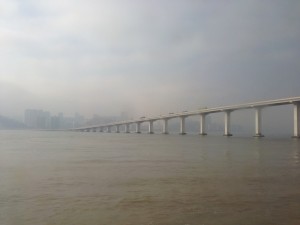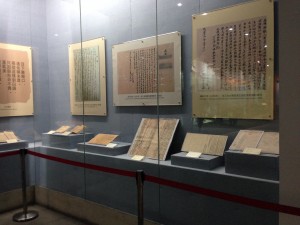For the first ten years of her married life, Ham Hop lived the life of a gum saan po (金山婆 jinshanpo), a Gold Mountain wife. Soon after they had married in Hong Kong in 1900, Ham Hop’s husband returned to Australia where he was a produce merchant in Victoria. Exactly where and how Ham Hop spent the years between 1900 and 1910 is not clear, but in June 1910 her husband returned with permission to bring her to live with him in Australia for six months.
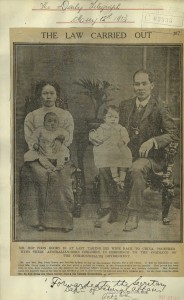
When they arrived in Melbourne in November 1910, Ham Hop was already about two months pregnant and so with the birth of her daughter falling at around the time she was meant to leave Australia, permission was granted for her to remain further, but just temporarily. Over the next two years, her exemption certificate was extended a total of five times (including because of a second pregnancy and the birth of another daughter), until she finally left Australia for good in May 1913.
Ham Hop’s case is one of the most-cited examples of the injustice and unfairness of the White Australia Policy in the early decades of the twentieth century — except mostly Ham Hop’s name doesn’t appear in such discussions. If she is referred to directly, it’s mostly as Mrs Poon Gooey or Poon Gooey’s wife, and her story is known as the Poon Gooey case. Yet this case is framed around some of the most personal and intimate of moments in a woman’s life — her betrothal and marriage, her reunion with her migrant husband, her pregnancies, the births of her daughters, her post-natal health, breastfeeding and the health of her newborn daughters. In the article I’m writing about the case I want to make her the centre of the story, not her husband, not the bureaucrats, not the law, not public opinion.
Records in Australia tell us only so much about the lives of Chinese who lived in Australia. In the case of Ham Hop, they tell us quite a lot about the three years that she was in Victoria, but what of the years before, when as a young woman she lived far apart from her husband, and of the years after. Snippets about Poon Gooey in Australian newspapers suggest that the family did go back to the village for a time at least, even though he seems to have been working in Shanghai in the mid-1920s. Ever-hopeful of research miracles, I decided to see what, if anything, I could find out in China. And so here I am.
Regular readers will know that I’ve been thinking about Ham Hop and Poon Gooey for quite some time now. Having first identified a name that I’m satisfied to call her, other than Mrs Poon Gooey, and establishing that her husband was from Kaiping, the next thing was to identify his home village.
Why his, I hear you ask, and not hers? Because it will be near impossible to identify where Ham Hop was from and even if I did, the likelihood of anyone there knowing anything about a woman who married out of their village more than a century ago is less than zero. In Australian records she is Ham Hop or Ham See or Hop Poon Gooey or Hope Poon Gooey. My best guess is that she was from Kaiping or maybe Taishan or Heshan, that her surname was Tan (譚) and her given name He (合), pronounced hup in Kaiping dialect.
There was more to go on to identify Poon Gooey’s origins — a passenger list that listed Poon Gooey’s origins as ‘Hoiping’, other Poons in Victoria from Kaiping, and student passports of Poon boys (held in the National Archives) that named the villages they came from — and using the various village databases I narrowed it down to a few particular villages. The villages are in Kaiping city, Yueshan town, Qiaotou village (開平市月山鎮橋頭村). I thought possibly, just possibly, someone in one of them might know something about what happened to Poon Gooey and his family after they returned to China one hundred and two years ago.

In Kaiping I’m staying at an organic farm, Jiayiyuan (嘉頤圓), and Selia Tan and her husband joined me here for breakfast (congee, roasted sweet potatoes, corn on the cob, choy sum, a type of steamed cake called faat tay and fresh hot soy milk) before we set out for the villages. It was a good thing breakfast was so sustaining because it was afternoon tea time before we stopped for a break.
We hadn’t made any contact with the villages before turning up, so after turning off the main road we just drove until we spotted the gate of one of the villages I’d identified from the village databases, Zhongheli (中和里).


Just turning up like this isn’t the most effective use of time if you have a really strict schedule and definitely want to contact relatives or see a particular family home while you’re in a village, but I think it’s more enjoyable to be able to wander at will, at least for a first visit. Getting the officials from the local Overseas Chinese Bureau involved takes away a lot of one’s freedom (my visit yesterday to Shiquli in Xinhui is a delightful but exhausting case in point — more on that in another blog post).
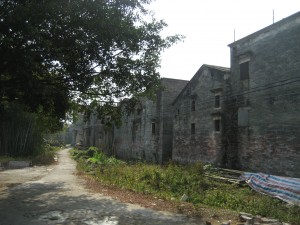
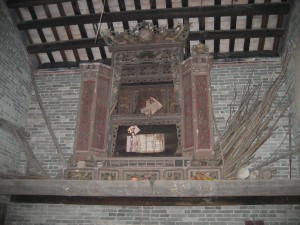
Many of the houses in Zhongheli village looked like huaqiao houses, and most of them weren’t being lived in. We spoke to one lady who said that she’d married into the village more than 40 years ago and had never seen anyone return to visit these houses.
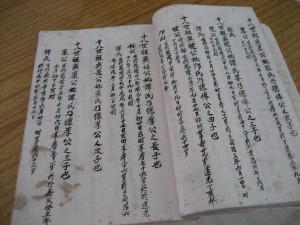
Another man said that he’d be able to help us see a copy of the Poon genealogy and eventually we ended up in house of a very lovely older lady inspecting the copy of the genealogy her father-in-law had written out by hand many years ago. Unfortunately it was a copy of their direct branch only, and we didn’t find Poon Gooey’s name. From the dates of others listed in the genealogy, Poon Gooey is likely to have been of the 18th or 19th generation.

It turns out that there are eleven little villages (里 li) in the larger village (村 cun) of Qiaotou, all home to people of the surname Poon/Pan (潘). As people returned from overseas, they would find a new bit of land and build a new huaqiao village. Then as those villages became abandoned again when people moved to Hong Kong or went back overseas, more new villages would be built by those people remaining in the area when they needed more housing.

So, armed with directions for another of the Australian Poon villages I’d identified, we set off again. From the records I’d seen in Australia, I reckoned that this village, Zhaolongli (肇龍里), was most likely to be where Poon Gooey was from (or perhaps where he built a house on returning from Australia in the 1910s). The layout and architecture in the village marks it very clearly as a huaqiao village and from the village entrance we could see a diaolou (碉樓) and the roofs of several yanglou (洋樓) poking out above the roofs of the other houses.

We spoke to three gorgeous old men (with fantastic gold false teeth!) who told us that many, many people from Zhaolongli were Australian, but that their houses now mostly sat empty. In fact, they said, their grandfathers or great-grandfathers had all been in Australia, but they had no idea when they went or where they went to. They also told us that the village’s ancestral hall had been destroyed during the Cultural Revolution, and all that remained was one of the front pillars.

The village is set out very neatly, facing onto a pond, with front and back gates (門 men) on either side. The houses are lined up in a grid pattern, with a lane way between each two houses, for light and air and for circulation. Huaqiao villages like this, built in the 1910s, 1920s and 1930s, were usually built in a very orderly pattern, with a building code that regulated the size of the houses and their layout.



At the very back of Zhaolongli, backing onto the hill, are four yanglou. While most of the other houses are single storey, the yanglou are much taller — three or four storeys. The yanglou are all abandoned and already fallen into disrepair, but once they would have been truly beautiful. And sitting high on the hill, the view from the upper floors and roof would have been lovely. One of the houses is in particularly bad repair, as trees (figs, maybe) are growing in the walls and the roots are creating large cracks separating the front wall from the side walls. The Zhaolongli diaolou sits outside the back gate of the village. Its door was firmly shut so we didn’t go in.
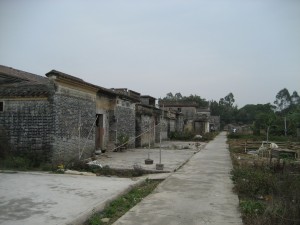

The third village I had identified was Nanjiangli (南江里), which is situated right next to Zhaolongli, although the road into the village comes in from a different direction. Nanjiangli, as the name suggests, is on the banks of a small and rather pretty river. It is smaller than Zhaolongli, but laid out on a similar grid pattern (although there is a lane way between each house, not every two houses as in Zhaolongli). Many of the houses in Nanjiangli, those towards the back of the village, have two storeys. At the back of the village is one smallish yanglou (three storeys).
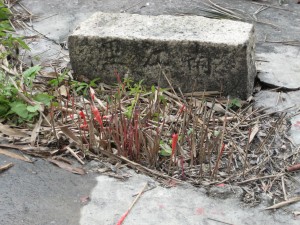
Few of the houses in Nanjiangli are lived in — we counted about half a dozen — but there were some people around, including two elderly men cutting bamboo for firewood. They each had a radio, one playing Cantonese opera and the other playing a story. They didn’t know of any particular connection the village had to Australia, saying that people had gone to Hong Kong — but it’s likely that they were thinking of later generations, from the 1930s and after, and it’s possible that earlier generations had been in Australia (actually, I know they were from the student passport records).

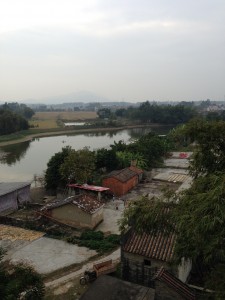
Nanjiangli’s dialou is located outside the village gates, on a small hill. As we were clambering about through the bushes to take photographs, a man told us that it was open and that we should climb up to have a look. So we did. The stairs inside are concrete, narrow but sturdy. The diaolou, like many, is being used now for storing firewood and hay. We had hoped to be able to see over the roofs of Nanjiangli village from the top of the diaolou, but the view over the houses themselves was obscured by a beautiful grove of bamboo.

No one in these Poon villages could tell me anything directly about Poon Gooey and his family, but the visit was definitely worthwhile. I’m confident now to say that Poon Gooey was from Qiaotou village, Yueshan town in Kaiping, and I think my initial feeling about Zhaolongli was probably right.
Putting the pieces together, I suspect that their life after leaving Australia went something like this. In 1913, they probably went back to Kaiping, perhaps built a house, then lost all the money they had brought back from Australia after a bandit attack (from their appearance, Selia Tan thought the two diaolou we saw would have been built in the 1920s, so they perhaps weren’t there when the bandits attacked Poon Gooey). Poon Gooey then returned to Australia to set the family’s finances back on track, coming and going between Victoria and China between 1914 and 1918, when he left Australia for the last time. In 1925, Poon Gooey was definitely in Shanghai, so it seems likely that the family were among the many Cantonese who moved to Shanghai around this time. From there, who knows.
Another satisfying thing about the visit is that I’ve worked out Poon Gooey’s name. In an early immigration document, his name is written as 潘如, while the Tung Wah Times wrote it as 潘巍. From the Cantonese and Mandarin the family name makes some sense being transliterated as Poon (pun in Cantonese, pan in Mandarin) and other common spelling variations I’ve seen in Australian records include Pon and Pong. In Kaiping dialect it is pronounced more like pwun, where the vowel sounds is like the ‘oo’ in book.
But the characters for Poon Gooey’s given name were either 如, which is pronounced yuh in Cantonese and ru in Mandarin, or 巍, pronounced ngaih in Cantonese and wei in Mandarin. Neither of these sounds much like Gooey. But, when pronounced in Kaiping dialect, the two characters sound more alike — 如 is pronounced nguey and 巍 pronounced ngai.
I think the proper characters for his name are therefore 潘如 (Pwun Nguey), since it sounds most similar to Poon Gooey and is the name written on a document Poon Gooey himself used when travelling to Australia in around 1900.

To finish off our visit to Yueshan, we went to the market town where there is a Christian church. Poon Gooey was a Christian, and fluent in English when he went to Australia in the 1890s. Other Poons in Australia were also Christian. I wonder whether the Poon Gooey family worshipped in this congregation sometimes?
